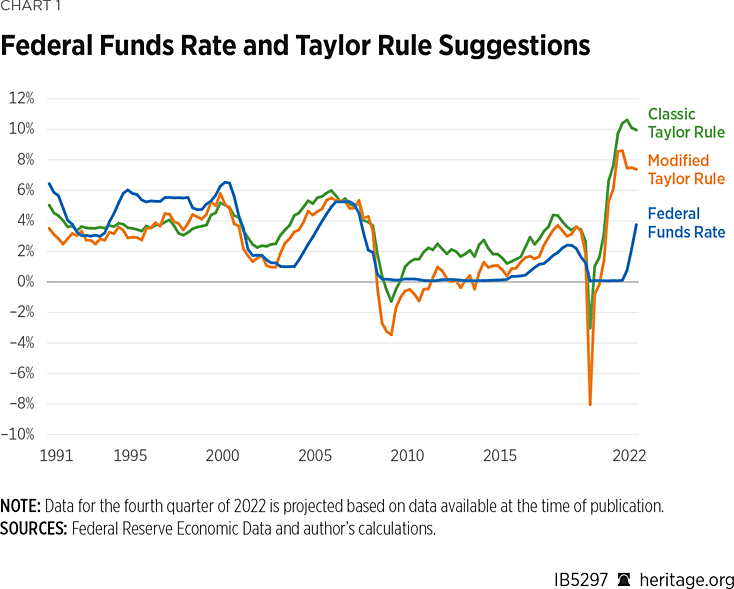On December 14, the Federal Reserve’s Open Market Committee (FOMC) announced an increase of 50 basis points in its monetary policy interest rate. The seventh straight increase signaled more caution, coming after four consecutive increases of 75 basis points as the Fed rushes to catch up with high inflation.
Chairman Jay Powell has signaled that the Fed may have slammed on the brakes too quickly. However, Powell has explained that the pace of rate increases over the next few FOMC meetings is less important than where rates will top out and how long they will stay there.
What can policymakers expect at the peak of this tightening cycle? The Taylor rule, a classic concept in monetary policy, suggests an answer.
The Taylor rule is a popular rule of thumb for guiding monetary policy based on inflation and the output gap.REF The current federal funds rate target is between 4.25 percent and 4.5 percent, but applying a Taylor Rule using current inflation rates suggests that the federal funds rate should be between 7.25 percent and 10 percent. Combining current data and near-term forecasts, it implies that interest rates could eventually be nearly twice as high as they are now.
Tighter monetary policy will raise costs for all Americans, and particularly for the federal government. The recent and expected interest rate increases from this tightening cycle will raise federal interest expenses by around $300 billion, about the cost of recent major spending bills.
Congressional Members and staffers should account for the likely path of monetary policy as they prepare budgets and appropriations bills. Policymakers will need to coordinate fiscal and monetary policy to bring down inflation and stabilize federal debt.
The Taylor Rule as a Guide for Monetary Policy
The Taylor rule is not a policy recommendation or optimal rule. It is an observation that approximately describes how the Fed has set monetary policy in the past, which informs what it may do in the future.
The formula for the Taylor rule is
r = π + 2 + 1/2 (π - 2) + 1/2 (y - y*),
where r is the nominal fed funds rate, π is the annual inflation rate over the previous four quarters, and y-y* is the output gap, or the percentage difference between the level of real gross domestic product (GDP) and potential real GDP.REF The intuition is that when inflation is at the target of 2 percent and the output gap is zero, then the nominal federal funds rate is 4 percent, implying a real federal funds rate of 2 percent.
The Taylor rule suggests that as inflation rises above the Fed’s 2 percent target, the Fed increases nominal rates to curb demand and bring down aggregate prices. It also suggests that the Fed raises rates when output is above potential and cuts rates when output is below potential. Though the parameters may vary between applications, the framework of interest rates responding to inflation and output is a workhorse of monetary policy analysis.
Intuitively, the Taylor rule summarizes the relationship between the Fed’s policy instrument and its policy goals—low inflation and maximum employment. When inflation is too high, the Fed raises rates, and vice versa. When output is too low, the Fed cuts rates, and vice versa.
The Taylor Rule in Practice
The Taylor rule’s relative simplicity makes it easy to work with and a useful tool for back-of-the-envelope calculations. For example, if inflation is 6 percent and the output gap is –1 percent, the Taylor rule says the federal funds rate should be 6 + 2 + 1/2 (6 - 2) + 1/2 (-1) = 9.5 percent.

Chart 1 shows historical data for the federal funds rate along with two versions of the Taylor rule—the classic rule from John Taylor’s 1993 paper, and a modified version suggested by former Federal Reserve Chairman Ben Bernanke, which places greater emphasis on the output gap.REF
Looking at historical data, the Taylor rule is a good approximation of how the Fed sets policy. Other factors aside from inflation and the output gap may have influenced the Fed to be tighter than the rule suggested during the 1990s and looser than suggested in the 2000s, but the factors in the Taylor rule capture most of the variation in interest rates.
At the present time, both versions of the Taylor rule suggest that interest rates should be much higher than the actual range of between 4.25 percent and 4.5 percent. The classic Taylor rule suggests rates around 10 percent, while the modified rule suggest rates around 7.5 percent.
Forecasts for Monetary Policy
If the pace of increases continues, the federal funds rate could be around 6 percent or 6.25 percent by March 2023, likely close to what either Taylor rule would suggest at that time. After reaching a peak, rates will come down as inflation comes down and as higher rates drag on output. In addition to the Taylor rule, other forecasts could be a useful guide to the potential peak of the fed funds rate.
The Fed regularly releases a summary of economic projections of the FOMC participants. In the December projection, the median estimate for the federal funds rate in 2023 was 5.1 percent.REF Just three months ago, the median estimate was 4.6 percent, with no estimate higher than 5 percent.REF Estimates for 2023 clustered between 5.1 percent and 5.4 percent (up from 4.25 percent and 5 percent). There is greater dispersion as rates come back down in 2024 and after, indicating differing perspectives on how long rates will stay elevated.
Similarly, the Atlanta Fed maintains a tracker that uses market data to derive the expected path of the federal funds rate.REF Market participants agree with FOMC projections, with the point estimate from the market forecast topping out just under 5 percent in March 2023 and declining after June.
Why do the forecasts predict much lower values than the Taylor rule? The federal funds rate is no longer the only monetary policy tool that the Fed uses. The Fed also issues forward guidance—statements about its expectations for future policy—and adjusts the size of its portfolio of assets. Accounting for those additional tools could mean that the effective stance of monetary policy is tighter than suggested by the federal funds rate alone.REF If that is the case, the federal funds rate may top out lower than what is suggested by the Taylor rule, consistent with outside forecasts.
Combining the insights of the Taylor rule and outside forecasts, fiscal policymakers should be prepared for the federal funds rate to reach between 5 percent and 7 percent in the near future.
Rising Rates Will Increase the Federal Deficit
What does a federal funds rate of between 5 percent and 7 percent mean for fiscal policymakers?
Rising interest costs will require significant adjustments to the federal budget just to keep the deficit constant, much less reduce it to levels that would stabilize federal debt. Using another rule of thumb from the Congressional Budget Office (CBO), based on its forecast from May 2022, if interest rates over the next 10 years are just 1.0 percent higher than originally projected, the federal deficit will increase by an additional $2.5 trillion over 10 years.REF In the six months since that forecast was released, rates on 10-year Treasury notes are already about one percentage point higher than forecast for 2023.
How do outside forecasts compare to the CBO’s? The median FOMC participant puts the federal funds rate in 2025 at 3.1 percent, while the Atlanta Fed’s Market Probability Tracker expects 3.8 percent. Using a conservative average of the term premium on 10-year Treasuries of 1 percent,REF borrowing costs for the federal government could be between 0.7 percent and 1.6 percent higher than the CBO forecast through 2025—around $100 billion per year. If rates rise to match the Taylor rule, costs would be even higher.
The Fed’s current tightening cycle represents an end to the loose policy that monetized much of the spending during the COVID-19 pandemic. While a tighter policy should reduce the inflation that resulted from the additional spending, it will also increase the amount of outstanding federal debt, as well as increase the risk of a debt crisis if Congress does not reduce the federal budget deficit.
Parker Sheppard, PhD, is Director of the Center for Data Analysis at The Heritage Foundation.



